Physical Address
304 North Cardinal St.
Dorchester Center, MA 02124
Physical Address
304 North Cardinal St.
Dorchester Center, MA 02124
Choosing a furry friend is fun. Bulldogs and pit bulls are both popular. They have unique qualities. It’s key to see how they are alike and different. We’ll look at things like how they act, look, and their health. We’ll also explore how easy they are to train and if they are good with kids.
Looking at these things will help you choose the best breed for you. Are you ready to learn about bulldogs and pit bulls? Let’s find out what makes these dog breeds so loved.
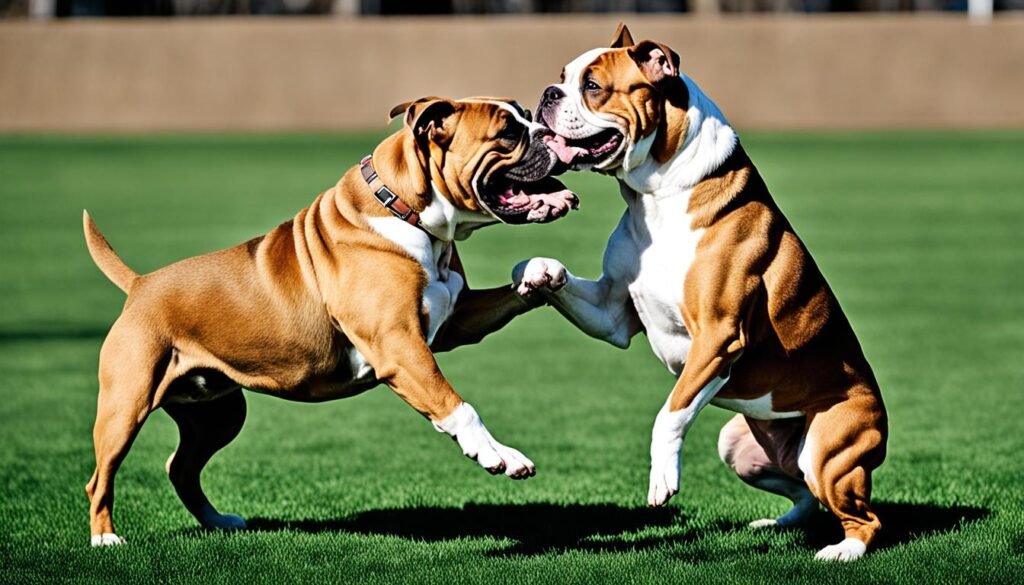
When we look into the dog world, it’s key to know what makes each breed special. Bulldogs and pit bulls stand out in their own ways. We’ll focus on two types: the American Bulldog and the Pitbull breeds.
The American Bulldog shines with its strong muscles and jawline. It shows strength and speed. This breed is hardworking and a faithful friend.
Pitbull breeds include different kinds, like the American Pit Bull Terrier, American Staffordshire Terrier, and Staffordshire Bull Terrier. They’re known for being friendly and smart. They love people, learn quickly, and are happy to please.
It’s key to see how these two breeds are different to choose the right one for you. The American Bulldog is all about strength. On the other hand, Pitbull breeds are friendly and smart.
Now, we’ll look more at the American Bulldog and Pitbull breeds to understand their unique traits.
The American Bulldog and pit bulls differ a lot. The American Bulldog is bigger and heavier. It has a huge head. Pit bulls are more agile and a bit slimmer. These differences change how they look and move.
The American Bulldog is strong and muscled. Males weigh 70-120 pounds and are 22-27 inches tall. They have a big, square head. This makes them look strong and tough. Bulldogs are chunky with a wide chest. They seem very imposing.

Pit bulls are known for being fast and athletic. They are a medium-sized breed. Males weigh 35-65 pounds and are 17-21 inches tall. Pit bulls are lean and quick, allowing them to move fast.
“The American Bulldog’s bigger size and head make them look very strong. Pit bulls are made for speed,” notes Sarah Johnson. She’s a dog expert with 10+ years of experience.
American Bulldogs are often picked for jobs needing strength, like guarding. Pit bulls are great at sports that need quick moves, like agility contests.
| Breed | American Bulldog | Pitbull |
|---|---|---|
| Average Weight | 70-120 pounds (32-54 kg) | 35-65 pounds (16-29 kg) |
| Average Height | 22-27 inches (56-69 cm) | 17-21 inches (43-53 cm) |
| Head Size | Large and square-shaped | N/A |
| Agility | Less agile | Highly agile |
| Physique | Powerful and sturdy | Lean and athletic |
Looking into bulldogs and pit bulls as pets means understanding their behavior. Both breeds are loyal and love their families deeply. Yet, they do have differences important for future owners to know.
Bulldogs are known to be confident and social. They are friendly and good with both people and families. These dogs are calm and gentle, beloved as family pets.
They are very affectionate and patient, especially with kids. This makes them excellent companions.
Pit bulls are playful and full of affection. They are active dogs that enjoy being with their human families. They fit well with active families because of their energy and friendliness.
It’s key to train and socialize them early. This helps direct their energy and enthusiasm positively.
Both breeds can vary in temperament. Many factors like genetics and their environment play a part. Good training and socialization are crucial for shaping a dog’s behavior.
“Bulldogs and pit bulls may differ in temperament, but they both can be loving pets. They thrive with the right care and training.”
Choosing between a bulldog and pit bull depends on your lifestyle and family. The time you can give for their training and socializing matters too. Talking to breed experts or breeders offers helpful insights into these breeds.
| Bulldog Temperament | Pit Bull Temperament | |
|---|---|---|
| Affectionate | Yes | Yes |
| Playful | No | Yes |
| Social | Yes | Yes |
| Confident | Yes | No |
| Patient with Children | Yes | Can be |
Both bulldogs and pit bulls need good training and care to be happy and healthy. Here’s what you should think about:
Bulldogs and pit bulls need daily exercise. This keeps them healthy in body and mind. Daily walks, yard playtime, or fetch can help use up their energy.
They need chances to run, explore, and be active. It stops them from getting bored and keeps them in shape.
Socializing your bulldog or pit bull is super important. Introduce them to various environments, people, and animals early on. This makes them friendly and well-adjusted.
Puppy classes or dog playdates can teach them to be social. It can also make them less likely to be aggressive or scared.
Both breeds need grooming to keep their coats healthy. Bulldogs have short coats but need care for their skin folds to avoid infection. Pit bulls’ short, smooth coats need less grooming, but regular brushing and occasional baths help.
Putting time into training is key for both breeds. Use positive reinforcement and rewards to teach them. Teaching them basics like sit, stay, and come is crucial for their safety.
Think about formal classes or a professional trainer for better training results.
Both breeds need toys for mental and physical work. Bulldogs do well with puzzle feeders. Pit bulls need strong chew toys for their powerful jaws. Interactive toys also keep them happy during play.
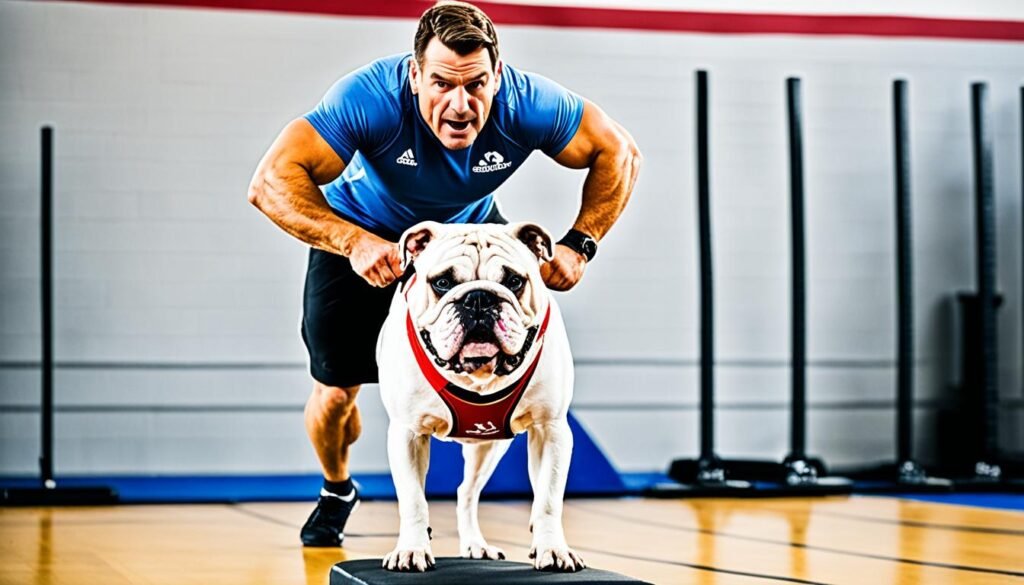
| Bulldog | Pit Bull | |
|---|---|---|
| Exercise Requirements | Regular exercise is important to prevent weight gain and maintain muscle tone. Moderate exercise, such as walks or short play sessions, is usually sufficient. | Pit bulls have high energy levels and require more exercise compared to bulldogs. They benefit from active play, runs, or longer walks to meet their exercise needs. |
| Socialization | Bulldogs typically have a calm and friendly temperament, but early socialization with other dogs and people is still important to prevent potential aggression or fearfulness. | Pit bulls require extensive socialization from a young age due to their strong protective instincts. Positive exposure to various environments, people, and animals is crucial to ensure their well-rounded behavior. |
| Grooming | Bulldogs have short coats that require regular brushing to minimize shedding. Cleaning and drying their skin folds is necessary to prevent infection. | Pit bulls have short and smooth coats that are low maintenance. Regular brushing and occasional baths are usually sufficient to keep their coats healthy. |
| Training | Bulldogs are intelligent but can be stubborn, so consistent and positive reinforcement training methods work best. Focus on basic obedience commands and socialization skills. | Pit bulls are intelligent and eager to please, making them highly trainable. Positive reinforcement techniques and consistency are key to their training success. |
Many believe bulldogs and pit bulls are the same, but that’s not true. They are different breeds, each with its own story. People also think these breeds are naturally aggressive. However, they can be friendly and sweet pets with the right care.
We’ll now clear up these false beliefs and reveal the real facts about bulldogs and pit bulls:
It’s vital to keep an open mind about breed myths. Learn from trustworthy sources. Understanding the truth about bulldogs and pit bulls helps you pick the right pet for your family.
For more information on pit bull myths and facts, you can visit this comprehensive article.
| Bulldogs | Pit Bulls | |
|---|---|---|
| Temperament | Affectionate, social | Affectionate, playful |
| Aggression | Depends on training and socialization | Depends on training and socialization |
| Appearance | Stocky, muscular | Athletic, lean |
| History | Working farm dogs | Bull-baiting and fighting pit origins |
To truly get the American Bulldog and Pitbull, we must explore their past. These working dogs come from rich histories that shape their traits and fame.
The American Bulldog started on farms as an all-around working dog. Farmers counted on them to protect and herd. Their strength, will, and loyalty made them vital on farms. This breed came to life in the U.S., evolving from English lines.
Strong and with a powerful bite, they were ideal for tough farm work. They were great guardians, keeping livestock safe from danger. Now, they’re loved pets, known for being loyal and protective.
Pitbulls have a debated past. They were first bred in the UK for bull-baiting and later, dog fighting. They were chosen for their fierce and strong nature in battles.
Despite their dog fighting past, pitbulls changed a lot. In the 1900s, they were called “Nanny Dogs” because of their kind nature with kids. This shows their deep loyalty and love, despite their violent history.
Now, pitbulls are often judged wrong because of their dog fighting history. Yet, with the right breeding, training, and socialization, they become wonderful pets. Many pitbulls are now valued for being loving and faithful friends.
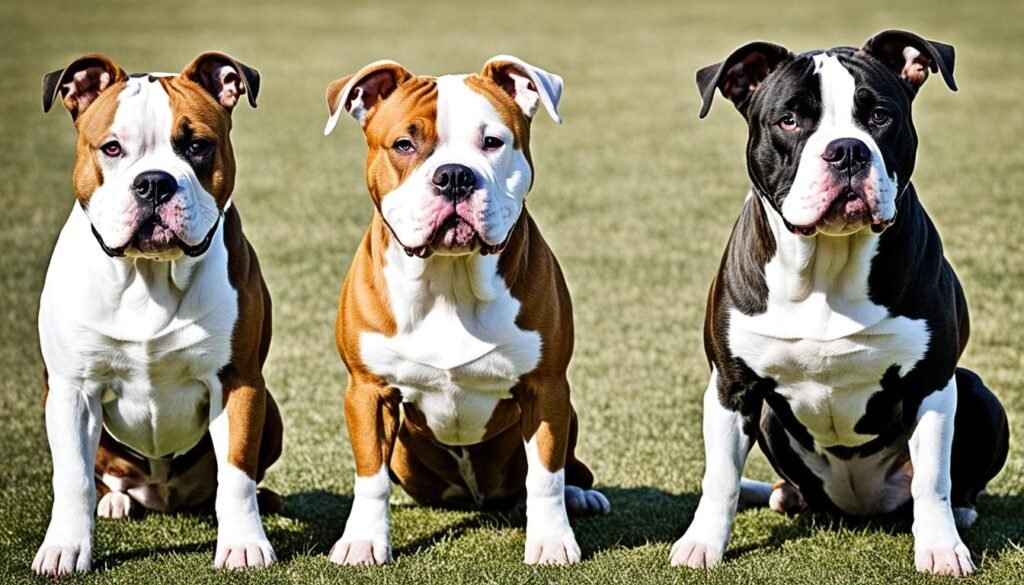
Learning about the American Bulldog and Pitbull’s past helps us understand them better. We see what makes them special and learn to see them as the loyal friends they are.
In some places, laws target certain dog breeds, like pit bulls. These laws, called breed-specific legislation (BSL), cause much debate. People for pit bull bans say it’s for safety, noting aggressive incidents. But, others argue BSL is unfair and doesn’t work.
Dog owners should know the legal and ethical sides of BSL. This means knowing the rules where you live and how they affect owning a pit bull. Being a good dog owner is about following the law. And, making sure your dog and people around are safe.
Being a responsible owner means learning about dog behavior and care. You should socialize your dog early, give them exercise, and train them with positive reinforcement.
“Responsible dog ownership means not only following the laws but also taking the necessary steps to ensure the well-being and safety of both the dog and the community.”
We can address concerns about BSL by promoting responsible dog ownership. Education, training, and socialization for all breeds can make dogs and humans live safer together.
BSL is a hot topic, with many different views. It’s key to talk about it with respect to understand all aspects of the issue.
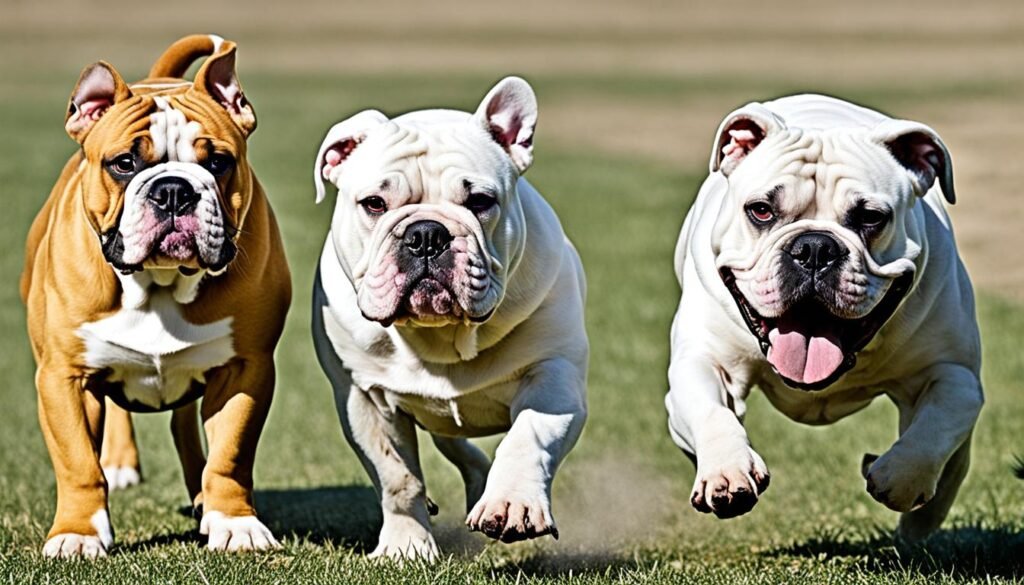
| Pros of Breed-Specific Legislation | Cons of Breed-Specific Legislation |
|---|---|
| Perceived public safetyReduces incidents of dog bitesProvides a sense of security | Discriminatory towards specific breedsIneffective in reducing overall dog-related incidentsMay result in the euthanization of innocent dogs |
| Ethical Implications | |
| Limits individual freedomsCan perpetuate stereotypes and stigmatizationPotential violation of animals’ rights |
Bulldogs and pit bulls often face health issues. Owners need to know about these conditions. This helps them care for their pets better.
Bulldogs face several medical problems. Hip dysplasia is one, causing pain in their joints. They also get allergies often, leading to skin and gut problems.
Also, bulldogs might have neurological issues. These include epilepsy or disc disease in their spine.
Pit bulls have their own health troubles. Heart conditions like dilated cardiomyopathy are one. They need regular check-ups and care.
They often get skin issues too. This includes allergies and irritations. Owners should deal with these problems quickly.
For bulldogs and pit bulls, regular vet visits are key. Vets can spot and treat problems early. Pets need good food, exercise, and a clean home too.
“Regular veterinary check-ups are vital to ensure the overall well-being of bulldogs and pit bulls.”
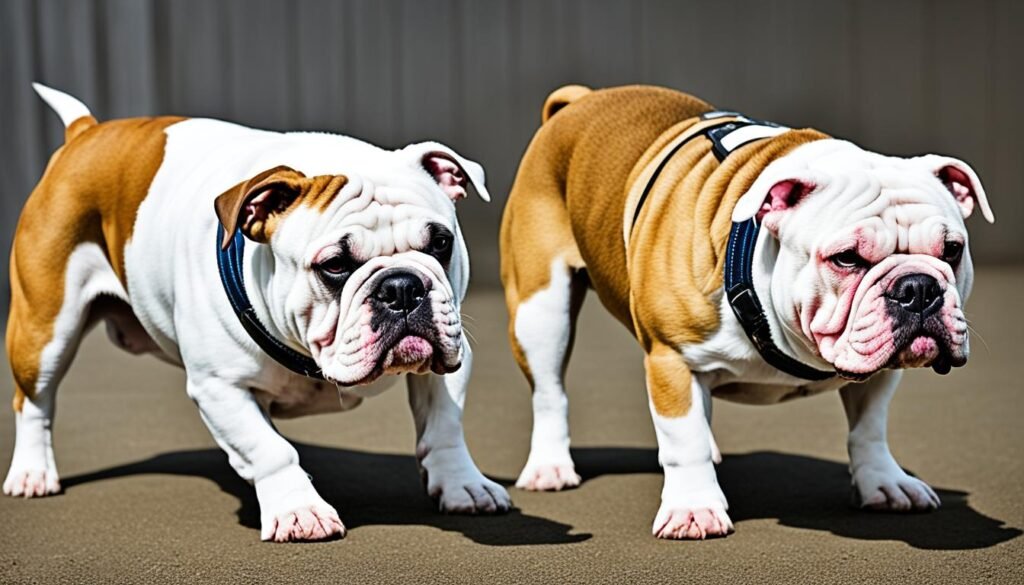
When caring for these dogs, use the right products. GPS dog collars keep them safe. For skin problems, special shampoos help their skin stay healthy.
In conclusion, comparing bulldogs and pit bulls shows their unique traits. These should be thought of when picking a pet. Both can be loving, loyal pets with the right care and training.
It’s key to know their differences in temperament, looks, health, and training. Bulldogs are bold and social. Pit bulls are playful and sweet. Bulldogs look bigger with a massive head. Pit bulls are leaner and more agile. This affects their looks and how active they are.
Both can have health issues like allergies and joint problems. Bulldogs may get hip dysplasia. Pit bulls might have heart conditions. Knowing these can help you care for them better.
Choosing between a bulldog and a pit bull depends on your own situation. Think about how active you are, your home size, and your family. Do lots of research. Talk to good breeders or experts. This helps make a smart choice. Before deciding, check out resources like this detailed study on breed traits and choosing dogs for more info.
Bulldogs have strong muscles and a powerful jaw. Pit bulls are agile and a bit leaner.
Bulldogs are seen as confident and like being around people. Pit bulls are playful and loving.
Both need regular exercise, meeting new people and animals, and training to behave and follow commands well.
Both can be great with kids when they are taught how to act around them. Always watch them, though.
It’s not true that all American Bulldogs are pit bulls. Also, it’s not fair to say they’re all aggressive.
Bulldogs got started as farm dogs. Pit bulls were first used in bull-baiting and then dog fighting.
Some places have laws against pit bulls. This has started much debate on safety and responsible pet care.
Bulldogs may get hip problems and allergies. Pit bulls could have heart and skin issues.
Think about your life and what you like. Look at what makes each breed special to decide which is better for you.